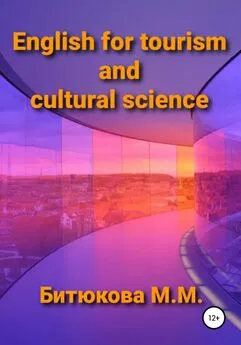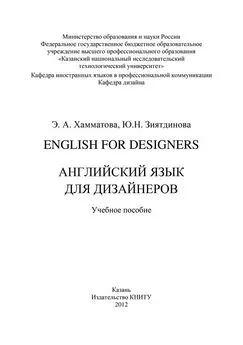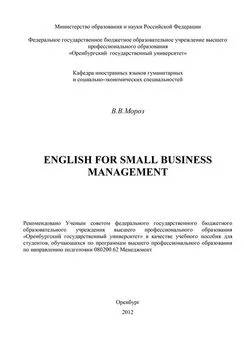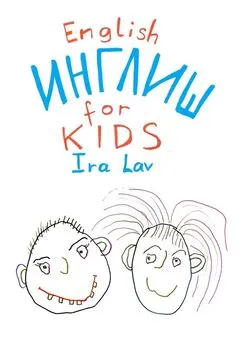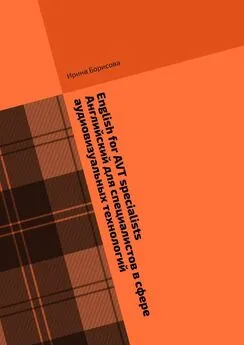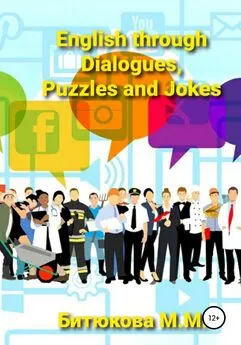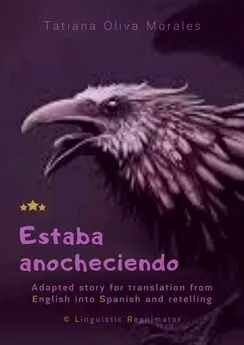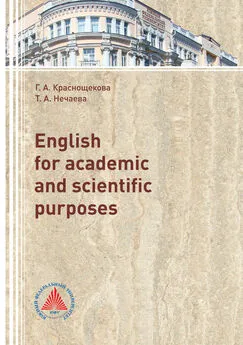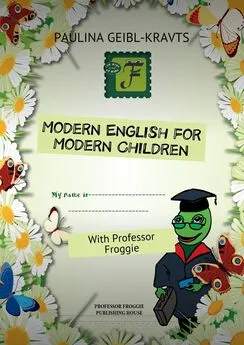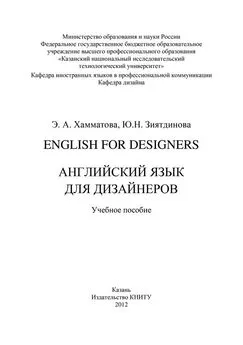М. Битюкова - English for tourism and cultural science
- Название:English for tourism and cultural science
- Автор:
- Жанр:
- Издательство:неизвестно
- Год:2020
- ISBN:нет данных
- Рейтинг:
- Избранное:Добавить в избранное
-
Отзывы:
-
Ваша оценка:
М. Битюкова - English for tourism and cultural science краткое содержание
English for tourism and cultural science - читать онлайн бесплатно ознакомительный отрывок
Интервал:
Закладка:
Foundry Bridge – Литейный мост
Gatchina – Гатчина (Государственный художественно-архитектурный дворцово-парковый музей-заповедник «Гатчина»)
Gatchina Palace – Гатчинский дворец
Grand Palace of Peterhof – Большой дворец Петергофа
Gulf of Finland – Финский залив
Hay Market – Сенной рынок
Hermitage – Государственный Эрмитаж
Imperial Estate of Pavlovsk – императорская резиденция в Павловске
Kazan Cathedral – Казанский собор
Lyceum – Царскосельский Лицей
Marble Palace – Мраморный дворец
Mariinsky Palace – Мариинский дворец
Mariinsky Theatre – Мариинский театр
Mars Square – Марсово поле
Museum of the history of Religion and Atheism – Государственный музей истории религии
Musorgsky Opera and Ballet Theatre – Театр оперы и балета имени М.П. Мусоргского
Nikolsky Cathedral – Никольский собор
Palace Bridge – Дворцовый мост
Palace Square – Дворцовая площадь
Paul’s War Hall – Зал Войны императора Павла I в Павловском Дворце (Павловск)
Peter and Paul’s Cathedral – Петропавловский собор
Peter and Paul’s Fortress – Петропавловская крепость
Peter the Great's Museum of Anthropology and Ethnography (Kunstkammer) – Музей антропологии и этнографии им. Петра Великого (Кунсткамера)
Peterhof – Петергоф (Государственный художественно-архитектурный дворцово-парковый музей-заповедник «Петергоф»)
Rastrelli Square – Площадь Растрелли
Russian Museum – Государственный Русский музей
Smolny Cathedral – Смольный собор
Smolny Institute – Смольный Институт
St. Isaac’s Cathedral – Исаакиевский собор
St. Michael’s (Engineers) Castle – Михайловский (Инженерный) замок
Stroganov Palace – Строгановский дворец
Theatre Square – Театральная площадь
Tovstonogov Bolshoi Drama Theatre – Большой Драматический Театр имени Г. А. Товстоногова (БДТ)
Trinity Bridge – Троицкий мост
Tsarskoye Selo – Царское Село (Государственный художественно-архитектурный дворцово-парковый музей-заповедник «Царское Село»)
Upper & Lower parks – Верхний и Нижний парки в Петергофе
Winter Palace – Зимний дворец
Vocabulary
1. To be informally known as – в разговорной речи известный как
2. A process of gradual development – процесс постепенного развития
3. Stone by stone – камень за камнем
4. To dazzle the eye of a visitor – завораживать посетителя
5. Perfectly-planned architecture – идеально спланированная архитектура
6. To be renamed into – переименованный в
7. To bring smb. to power – привести к власти
8. To transfer the capital to – перенести столицу в
9. To preserve – сохранять
10. Heroic resistance – героическое сопротивление
11. The cradle of the city – колыбель города
12. To comment with – акцентировать внимание на
13. The burial vault of Russian Tsars – усыпальница русских царей
14. The museum of space exploration and missilery – музей космических исследований и ракетостроения
15. A great spot for taking pictures – замечательное место для фотографирования
16. Old slum areas – район трущоб
17. To outline one’s life and work – охарактеризовывать (обрисовывать) жизнь и творчество
18. To display a diverse range of art – демонстрировать разнообразные направления в искусстве
19. In the very centre of the city – в самом центре города
20. A great number of – огромное количество
21. Decorative and applied art – декоративное и прикладное искусство
22. Embankment – набережная
23. Miracle-working icon – чудотворная икона
24. To make a strong competition to – составлять сильную конкуренцию
25. An outstanding example of a landscape architecture – яркий пример ландшафтной архитектуры
26. Mirrored ballroom – зеркальный зал
27. Well-preserved classrooms – хорошо сохранившиеся классные комнаты
28. To be filled with luxurious furnishings – наполненный роскошными убранствами
29. To be on tours – гастролировать
30. In recognition of one’s merits and talent – в качестве признания чьих-либо заслуг и таланта
31. An affiliate of – филиал
Tasks on the text
1. Make up special questions concerning the information about St. Petersburg from the text.
2. Match numbers and dates on the left with the events on the right.

3. Choose the odd one out in each line and explain.
a) Vasilyevsky, Petrogradsky, Mariinsky, Krestovsky, Yelagin.
b) St. Isaac’s Cathedral, St. Basil’s Cathedral, Peter and Paul’s Cathedral, Church of the Savior on the Spilled Blood.
c) Neva, Palace, Trinity, Anichkov, Foundry.
d) Gatchina, Peterhof, Pavlovsk, Kunstkammer.
e) Upper Park, Samson, Catherine Palace, Lower Park.
f) Amber Room, Italian Hall, Paul’s War Hall, Greek Hall.
g) Palace Square, Arts Square, Red Square, Decembrists Square.
Discussion
Choose one or two of the following questions and discuss them in pairs. Then share your ideas with the whole group.
1. What attractions do you find the most interesting in St. Petersburg? How much time do you need to see all of them?
2. What season would you choose to go to St. Petersburg and why? Who would you prefer to go with? How many days would you like to spend there?
3. Compare Moscow and St. Petersburg. Why were these two cities the capitals of Russia and one of them still is? What is the most remarkable about each of them?
4. Have you ever been to St. Petersburg? What was the first thing that attracted your attention? Why? Describe it.
5. How has the historical past influenced on St. Petersburg’s architectural and cultural life? Prove from the text.
6. Describe St. Petersburg (in general).
Tasks on Vocabulary
1. Find in the texts adjectives which are used to describe architectural monuments. Write them down. Use them to describe any attractions of the city for tourists according to the following plan:
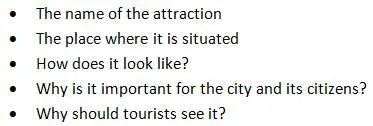
2. Translate these phrases into English using the words from the texts.
Акцентировать внимание на, зеркальный зал, демонстрировать разнообразные направления в искусстве, в самом центре города, переименованный в, чудотворная икона, усыпальница русских царей, в качестве признания чьих-либо заслуг и таланта, перенести столицу в другой город, процесс постепенного развития, огромное количество, район трущоб, гастролировать, замечательное место для фотографирования, декоративное и прикладное искусство, набережная, филиал.
3. Using the phrases from ex. 2 make up 5 your own sentences in Russian and in English on two separate pieces of paper.
Creative Tasks
The situation : Student A is a manager of a tour agency. Student B is a tourist who wants to visit St. Petersburg. He comes to the tour agency and asks for advice what to see in the city.
Use your imagination and information from the texts and make up a dialogue.
Revision Tasks
Choose any Russian city (except Moscow and St. Petersburg) – a tourist attraction – and prepare a short presentation according to the following plan:

Unit 3. England. London
Historical Review
London is the capital and largest urban area of both England and the United Kingdom. It is the largest city in the European Union and the ninth-largest city in the world. It has a very interesting and long history which spans nearly 2,000 years, beginning with the arrival of the Romans soon after their invasion of Britain in AD43.
The Romans (A43– 410). They laid out buildings, streets and a port, and shortly afterwards they built a bridge. They called the settlement Londinium and it soon became the capital of Roman Britain.
The Saxons and the Vikings. Later in the 5th century, Anglo-Saxons settled just west of Londinium and formed the town of Lundenwic. Saxon London consisted of many wooden huts with thatched roofs. In 842 the Danish Vikings looted London. They burned a large part of the town.
The Vikings and Saxons ruled jointly England until 1042, when Edward the Confessor became King of both the Vikings and the Saxons. Edward the Confessor (1042-1066) built a wooden palace at Westminster. Later Parliament met here. Because of this Westminster became the seat of government not the city of London itself. Edward also built Westminster Abbey, which was consecrated a few weeks before his death.
Tudor London (1485 – 1603). In 1485 Henry VII became King, followed by Henry VIII. They were the first Tudor kings (Tudor was their family name). London grew in importance under the Tudor rule. It became the centre of trade and government.
Henry VIII created palaces such as St. James. He is also famous for closing the city monasteries in 1536, after the Roman Catholic Church refused to grant him a divorce. During the reign of Elizabeth I, the daughter of Henry VIII, London was wealthy and successful city. Theatre became popular, helped by the arrival of playwright William Shakespeare sometime between 1585 and 1593.
Читать дальшеИнтервал:
Закладка:
